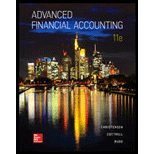
What types of investments in common stock normally are accounted for using (a) the equity method and (b) the cost method?
Introduction: The cost method is used for reporting investments in securities when equity method and consolidation reporting are inapt, whereas, equity method is a way by which external investors are informed.
To state: The types of investments in common stock that are accounted for using cost and equity method.
Explanation of Solution
Cost Method:
Under cost method, intercorporate investment in common stock are accounted at the historical cost. In case of marketable securities, the investment is shown at market value in the balance. This method is used for reporting when consolidation reporting and equity-method is inapt. The cost method is used when the company holds less than 20% in common stock of another company.
Equity Method:
Equity method is generally used when the investment in common stock is 20% or more than 20%. When the company holds 20% or more than 20% common stock of another company, the investor holds the control and significant influence on the investee.
Want to see more full solutions like this?
Chapter 2 Solutions
Advanced Financial Accounting
- I am looking for the correct answer to this general accounting question with appropriate explanations.arrow_forwardPlease provide the solution to this general accounting question using proper accounting principles.arrow_forwardI need assistance with this financial accounting problem using valid financial procedures.arrow_forward
- Accounting problemarrow_forwardRoyal Designs creates custom furniture. During November, it had applied an overhead of $162,000. Overhead is applied at the rate of 80% of direct labor cost. Direct labor wages average $32 per hour. How many direct labor hours did Royal Designs have for the month of November?arrow_forwardCan you explain the process for solving this financial accounting question accurately?arrow_forward
- Which circumstances require modified nominal account treatment? A. Nominal accounts never need modification B. Standard closing entries always suffice C. Special purpose entities demand unique closing procedures D. Year-end procedures remain constant. MCQarrow_forwardAssume that a company produced 12,000 units and sold 9,500 units during its first year of operations.arrow_forwardCalculate the predetermined overhead ratearrow_forward
 Cornerstones of Financial AccountingAccountingISBN:9781337690881Author:Jay Rich, Jeff JonesPublisher:Cengage Learning
Cornerstones of Financial AccountingAccountingISBN:9781337690881Author:Jay Rich, Jeff JonesPublisher:Cengage Learning College Accounting, Chapters 1-27AccountingISBN:9781337794756Author:HEINTZ, James A.Publisher:Cengage Learning,
College Accounting, Chapters 1-27AccountingISBN:9781337794756Author:HEINTZ, James A.Publisher:Cengage Learning, Intermediate Accounting: Reporting And AnalysisAccountingISBN:9781337788281Author:James M. Wahlen, Jefferson P. Jones, Donald PagachPublisher:Cengage Learning
Intermediate Accounting: Reporting And AnalysisAccountingISBN:9781337788281Author:James M. Wahlen, Jefferson P. Jones, Donald PagachPublisher:Cengage Learning Managerial AccountingAccountingISBN:9781337912020Author:Carl Warren, Ph.d. Cma William B. TaylerPublisher:South-Western College Pub
Managerial AccountingAccountingISBN:9781337912020Author:Carl Warren, Ph.d. Cma William B. TaylerPublisher:South-Western College Pub EBK CONTEMPORARY FINANCIAL MANAGEMENTFinanceISBN:9781337514835Author:MOYERPublisher:CENGAGE LEARNING - CONSIGNMENT
EBK CONTEMPORARY FINANCIAL MANAGEMENTFinanceISBN:9781337514835Author:MOYERPublisher:CENGAGE LEARNING - CONSIGNMENT





